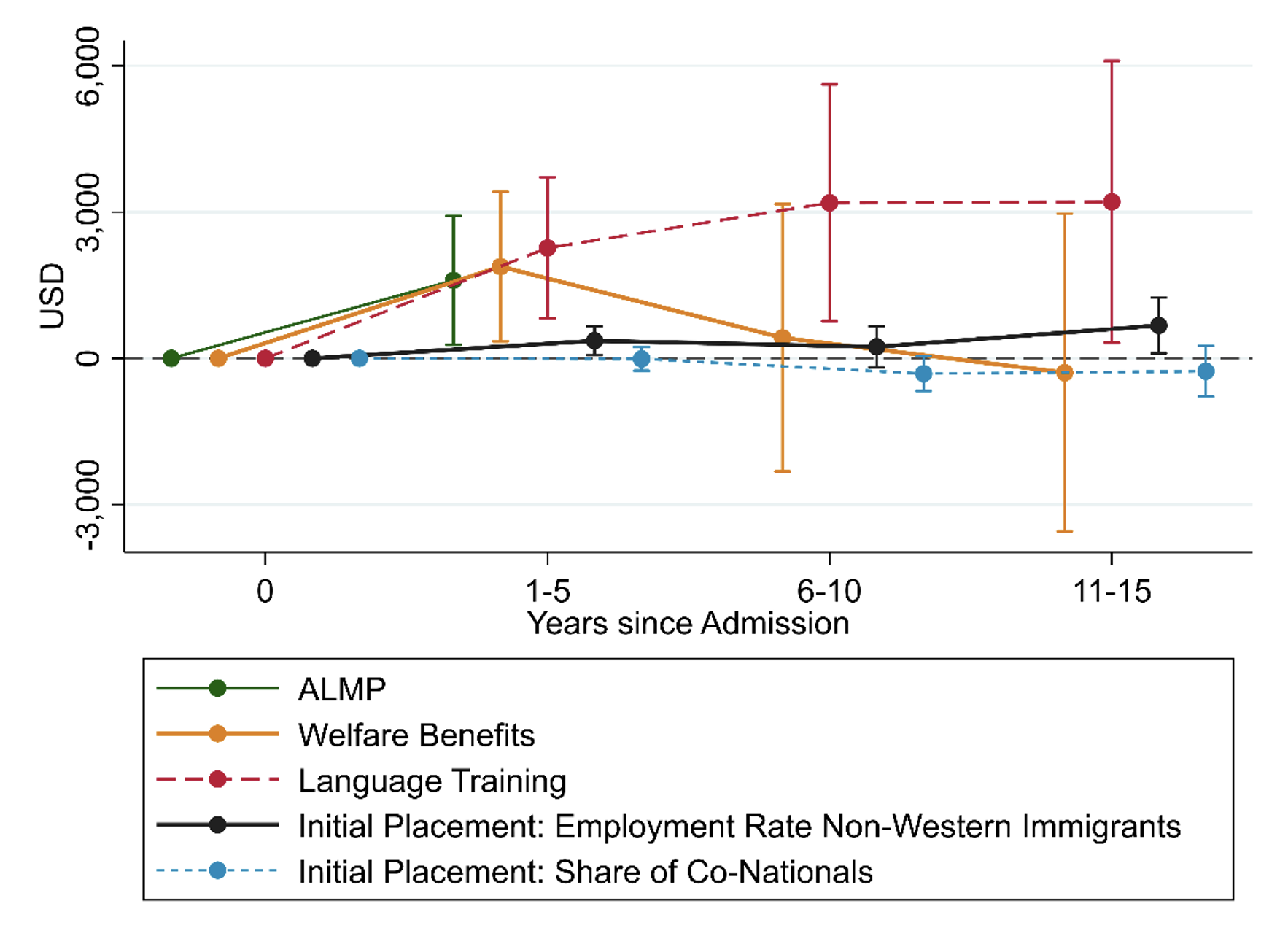Millions of Ukrainian refugees have been welcomed in countries across Europe since late February 2022. European governments allowed these refugees immediate access to labour markets and access to schooling for their children, adopting unprecedented policies that bode well for their economic success. However, there is a strong debate among European policymakers and voters about the ability of refugees to integrate economically. This issue is urgent, as existing studies show that refugees in Europe lag in their employment and earnings, relative to both similar natives and other immigrants (Brell et al. 2020, Schönberg et al. 2016).
Additionally, refugees from the Middle East and North Africa and women seem to have particularly large employment and earnings gaps many years after arrival. Schönberg et al. (2016) show a gap in employment probability between 15 and 20 percentage points between African refugees and other immigrants. This lack of assimilation reduces GDP and income generated by the refugees. A study by the IMF estimated a foregone GDP for Germany by almost half a percentage point from 2015 to 2020 from the limited assimilation of Syrian refugees (Aiyar et al. 2016).
What do we know about the effects of integration policies?
In a recent paper (Foged et al. 2022), we review recent studies that evaluate the causal labour market impact of four types of policies that constitute the main tools to support the economic integration of refugees. Then, focusing on Denmark, a country that has admitted refugees over the last 40 years and has experimented with different policies (Dustmann et al. 2022), we empirically evaluate the short- and long-run impact, after asylum, on employment and earnings of each of those policies.
The findings of recent studies using credible causal identification are as follows.
Active labour market policies
The impact of active labour market policies has been evaluated in four recent studies (Arendt 2022, Joona and Nekby 2012, Dahlberg et al. 2020, Battisti et al. 2019). These studies use randomised treatment-control experiments or sudden introduction of a policy (based on arrival date) to analyse the effectiveness of training, coaching, and job-search support. The studies analyse two policies in Sweden, one in Germany, and one in Denmark and find some positive effects on employment. However, due to data limitations, they are only able to look at short-term effects, within one or two years of arrival.
Welfare cash payments
Refugees in most countries qualify for initial cash transfers. However, the generosity of such transfer has varied across countries and over time. Three studies (Rosholm and Vejlin 2010, Huynh et al. 2007, LoPalo 2019) have used the sudden reduction of those welfare benefits (in Denmark) or their variation across US states to estimate their impact on employment and earnings of refugees.
Two findings emerge from the Denmark studies. First, they find small positive effects of the welfare cut on the probability of employment in the short run (one to two years from arrival) but do not estimate long-term effects. Second, the earnings from the increased employment are much smaller than the reduction in welfare transfers so refugees experienced a significant reduction in disposable income in the years after arrival.
Language classes
Three recent studies (Foged and van der Werf 2022 for Denmark, Lochmann et al. 2019 for France, Sarvimäki and Hämäläinen 2016 for Finland) estimate the impact of initial language training on employment of refugees. Due to the small samples used in those studies and the short time horizon considered, the estimated effects are usually positive but often weak.
Initial placement in locations with strong labour markets or large networks
Several studies used the fact that, in most countries, a resettlement authority decides the initial placement of refugees and, conditional on some observable variables, the placement is random. These studies analysed how employment rates and the size of co-ethnic networks in the initial location affect the economic success of refugees. Azlor et al. (2020) find that placing refugees in a location with higher employment of non-Western immigrants increases their employment probability within 2–4 years from arrival. A set of papers (Edin et al. 2003, Damm 2009, Battisti et al. 2022) find that a high density of co-nationals has small and unclear effects on labour market outcomes, and no study goes beyond 6–7 years from arrival.
New evidence on the long-run effects of policies
The studies summarised above reveal that there is not much evidence of the causal impact of refugee policies on long-run outcomes. In our paper, we focus on Denmark and identify one policy in each of the four groups described above, whose implementation allows us to cleanly identify its effects. Figure 1 shows the estimated impact on earnings (in 2015 US dollars) of each policy, in the short (1–5 years), medium (6–10 years), and long run (11–15 years), and the 95% confidence interval.
Figure 1 Estimated effects of different policies on refugees’ earnings in the short, medium, and long run
The green solid line shows the impact of active labour market policies. The estimates evaluate the ‘industry package’, a policy introduced in 2013 and progressively rolled out across municipalities in Denmark (see also Foged et al. 2021). This policy identified occupations experiencing labour shortages. Then, refugees chose one of those occupations/industries and the municipality provided a brief training for a job in the chosen industry. This programme was adopted by a subset of municipalities (treated) at different times. We evaluate its impact one year after asylum.
The estimates suggest a significant gain in employment and earnings (+$1,600). The appeal of such a policy is that it allowed faster integration in the labour markets while also addressing the labour market shortages of the host country. Due to the recent introduction of this policy and our empirical design, we are not able to go beyond short-run effects.
The yellow solid line in Figure 1 shows the effects on earnings in the short, medium, and long run of cutting welfare transfers by 40%. This cut was applied to refugees whose status was approved after 1 July 2002, and not to earlier refugees. We estimate that in the early years after arrival, such a cut increased earnings by $1,880 per year. This effect disappeared in the medium and long run (6 to 15 years). Additionally, as the drop in welfare transfer was close to $6,600 per year, refugees’ disposable income decreased significantly. A study focused on the same reform (Andersen et al. 2019) showed that when refugees had lower disposable income due to this cut, their children were more likely to drop out of school and to be convicted of a crime.
The largest and most lasting effects on earnings, represented in Figure 1 by the red line, correspond to a reform introduced on 1 January 1999 that increased language training by 430 hours in the first three years after arrival. The intervention increased the yearly earnings of refugees by more than $3,000 (about 15% of the earnings of an average refugee) in the medium and long run. Additional analysis in our paper shows that this effect accrued over time, due in part to higher employment rates and also to higher mobility towards communication-intensive jobs that are better paid (see also Foged et al. 2021).
Figure 2 shows the effects of the language reform on refugees’ earnings, by gender (Panel a), by close/far linguistic origin (Panel b), and by initial placement in a location with a high/low employment rate for immigrants (Panel c). The graphs suggest a stronger impact on women’s yearly earnings (+$3,400 in the long run versus $2,900 for men) and on refugees with languages farther from Danish (+$3,950 versus +$1,600 for linguistically close). Therefore, the groups benefiting most from language training are those who have the largest initial employment and earnings gap with natives. Panel (c) suggests stronger earning effects when refugees were placed initially in areas with a high employment rate of immigrants.
Figure 2 Effect of language training on earnings of refugees by gender, linguistic origin, and initial placement
Finally, the black and blue lines in Figure 1 show the effects on refugees’ earnings of being initially placed in locations with a larger employment rate or larger network size of co-nationals, defined as people from the same country, as a share of the local population. The estimated effect is in response to a one-standard-deviation increase of the variable in the initial location. The effects of a larger network of co-nationals are small and not significant in any period. However, refugees initially placed in a location with one-standard-deviation-higher employment rates of non-Western immigrants enjoyed higher yearly earnings by about $675 in the long run.
In summary, the magnitude, significance, and time profile of the estimated effects imply that language training and placement in strong labour markets are the most effective policies in promoting refugee integration in the long run.
References
Aiyar, S, B B Barkbu, N Batini, H Berger, E Detragiache, A Dizioli, C Ebeke, H Lin, L Kaltani, S Sosa, A Spilimbergo, and P Topalova (2016), “The refugee surge in Europe: Economic challenges”, IMF Staff Discussion Notes 2016/002.
Andersen, L H, C Dustmann, and R Landersø (2019), “Lowering welfare benefits: Intended and unintended consequences for migrants and their families”, Study Paper 138, The Rockwool Foundation’s Research Unit.
Arendt, J N (2022), “Labor market effects of a work-first policy for refugees”, Journal of Population Economics 35: 169–96.
Azlor, L, A P Damm, and M L Schultz-Nielsen (2020), “Local labor demand and immigrant employment”, Labour Economics 63: 101808.
Battisti, M, Y Giesing, and N Laurentsyeva (2019), “Can job search assistance improve the labour market integration of refugees? Evidence from a field experiment”, Labour Economics 61: 101745.
Battisti, M, G Peri, and A Romiti (2022), “Dynamic effects of co-ethnic networks on immigrants’ economic success”, The Economic Journal 132(614): 58–88.
Brell, C, C Dustmann, and I Preston (2020), “The labor market integration of refugee migrants in high-income countries”, The Journal of Economic Perspectives 34(1): 94–121.
Dahlberg, M, J Egebark, G Özcan, and U Vikman (2020), “Labor market integration of refugees: RCT evidence from an early intervention programme in Sweden”, arXiv preprint.
Damm, A P (2009), “Ethnic enclaves and immigrant labor market outcomes: Quasi-experimental evidence”, Journal of Labor Economics 27(2): 281–314.
Dustmann, C, H Ku, and J Arendt (2022), “Refugee migration and the labour market: Lessons from 40 years of post-arrival policies in Denmark”, VoxEU.org, 10 April 2022.
Edin, P-A, P Fredriksson, and O Åslund (2003), “Ethnic enclaves and the economic success of immigrants, evidence from a natural experiment”, Quarterly Journal of Economics 118(1): 329–57.
Foged, M, L Hasager, and G Peri (2021), “Language training and refugees’ success”, VoxEU.org, 20 March.
Foged, M, L Hasager, and G Peri (2022), “Comparing the effects of policies for the labor market integration of refugees”, NBER Working Paper 30534.
Foged, M, L Hasager, G Peri, J Nielsen Arendt, and I Bolvig (2022), “Language training and refugees integration”, The Review of Economics and Statistics.
Foged, M, J Kreuder, and G Peri (2021), “Refugees by addressing labor shortages? A policy evaluation”, NBER Working Paper 29781.
Foged, M, and C van der Werf (2022), “Language training and local integration of refugees”, CReAM Discussion Paper 10/22.
Huynh, D T, M L Schultz-Nielsen, and T Tranæs (2007), “Employment effects of reducing welfare to refugees”, Rockwool Foundation.
Joona, P A, and L Nekby (2012), “Intensive coaching of new immigrants: An evaluation based on random programme assignment”, The Scandinavian Journal of Economics 114(2): 575–600.
Lochmann, A, H Rapoport, and B Speciale (2019), “The effect of language training on immigrants’ economic integration: Empirical evidence from France”, European Economic Review 113: 265–96.
LoPalo, M (2019), “The effects of cash assistance on refugee outcomes”, Journal of Public Economics 170(C): 27–52.
Rosholm, M, and R Vejlin (2010), “Reducing income transfers to refugee immigrants: Does start-help help you start?”, Labour Economics 17(1): 258–75.
Sarvimäki, M, and K Hämäläinen (2016), “Integrating immigrants: The impact of restructuring active labor market programs”, Journal of Labor Economics 34(2): 479–508.
Schӧnberg, U, L Minale, F Fasani, T Frattini, and C Dustmann (2016), “On the economics and politics of refugee migration”, VoxEU.org, 18 October.









